

Graceland UniversityFormerly known as Graceland CollegeLamoni, Fayette Township, Decatur County, Iowa |
|
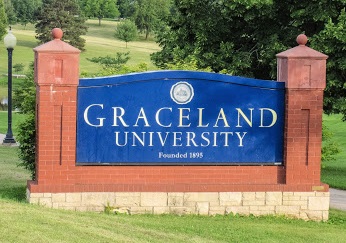 
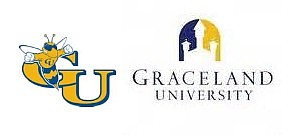 |
|
| Timeline of Graceland University | |
| Photos and Images | Acacia - yearbook |
| History of the Buildings and Complexes | Articles |
|
|
| Board of Trustees, Presidents, Faculty | |
|
Sisters Marietta WALKER and Minnie WICKES, along with Brother W. A.
HOPKINS donated land which, with the 26 acres of land purchased by the
RLDS Church from Brother HOPKINS, provided 66 acres located in the
southeastern portion of Lamoni for a college site. Due to the gentle
slope of this site, the school was named Graceland College. The corner
stone of the present-day administration building was laid with elaborate
ceremony on November 12, 1895. The building proper was dedicated on
January 1, 1897. The Articles of Incorporation for Graceland College (present-day Graceland University) were first read on December 31, 1999. The college was finally established by RLDS (now Community of Christ) General Conference Resolution Number 335 on April 11, 1890, empowering the committee to make all necessary arrangements toward the establishment of an educational institution. Members of the first official committee, which were appointed by General Conference Resolution Number 334, were: president Bishop G. A. Blakeslee, treasurer David Dancer and secretary Robert Winning. Edmund L. Kelley and Robert Winning were the committee on subscription lists. The first Board of Directors, then known as the “College Board,” was appointed by General Conference Resolution Number 339 on April 11, 1895, and convened for the first time on April 30, 1895. They were renamed the Board of Trustees on May 2, 1895. The name “Graceland” was given by Col. George Barrett, who surveyed the land for the college. He selected the name because of the graceful slope of the hill upon which the college was built. The name “Graceland College” became official on May 2, 1895 when the Board of Trustees cast their vote and approval. 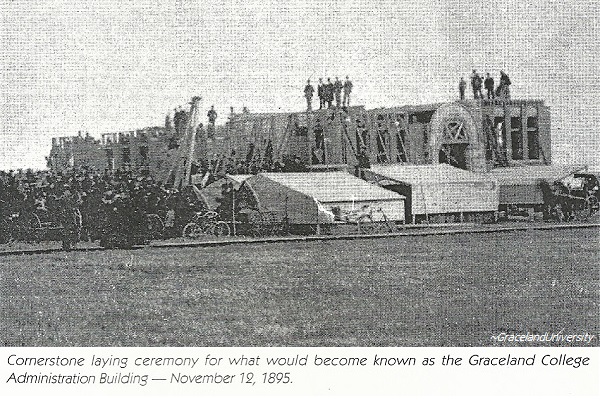 Land
for the college was donated by church members, with the first 20 acres
given by Marietta Walker, after whom Walker Hall is named. Until the
administration building was completed, classes were conducted in the
France Building, downtown Lamoni located at 126 Linden Street (west
side). Graceland rented six large rooms on the second floor – three
rooms on each side of a central hallway. Room #1 was the science room;
another room was for classics and English classes; one room for a
library and study hall; two rooms used for commercial classes; and, the
last room was used for fuel and supplies.
Land
for the college was donated by church members, with the first 20 acres
given by Marietta Walker, after whom Walker Hall is named. Until the
administration building was completed, classes were conducted in the
France Building, downtown Lamoni located at 126 Linden Street (west
side). Graceland rented six large rooms on the second floor – three
rooms on each side of a central hallway. Room #1 was the science room;
another room was for classics and English classes; one room for a
library and study hall; two rooms used for commercial classes; and, the
last room was used for fuel and supplies.The site of the France Building was platted in 1879. C. E. Perkins, acting as trustee for the Order of Enoch, sold the lot to Alice France in December of 1889. The France Building remained with the France family for 48 years. [During the 1970's Hy-Vee Food Store was located in the France Building.] During Founders Weekend centennial celebration, a plaque designating the historical significance of the France Building to Graceland was unveiled on September 23, 1995. The first day of classes was September 17, 1895. There were 18 men and women students, four faculty and a dean. Graceland's initial school year was divided into three terms: fall, from September 17 to December 20; winter, January 2 to March 27; and spring, April 7 to June 12. During the first term, recitations were held from 8 a.m. to noon and afternoons were dedicated to study. Goehner, David. “The Graceland College Book of Knowledge: From A To Z.” Pp. 123-25. Herald House. Independence MO. 1997. 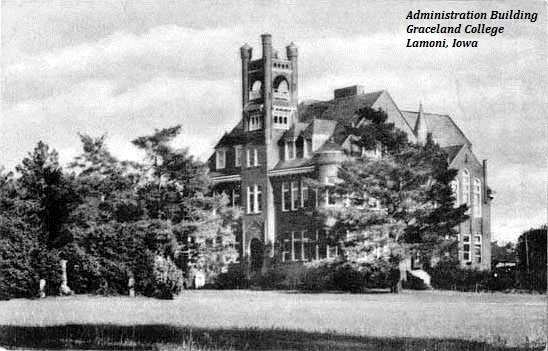 The
first building – present-day administration building – housed the
complete college. The cornerstone was laid on November 12, 1895.
Graceland's equipment and supplies were moved on-campus and into the new
building during the 1896 Christmas break. The building was dedicated on
January 1, 1897. The church president, Joseph Smith III, said on the day
of dedication that the college “should be free to all irrespective of
faith or creed.”
The
first building – present-day administration building – housed the
complete college. The cornerstone was laid on November 12, 1895.
Graceland's equipment and supplies were moved on-campus and into the new
building during the 1896 Christmas break. The building was dedicated on
January 1, 1897. The church president, Joseph Smith III, said on the day
of dedication that the college “should be free to all irrespective of
faith or creed.”Classes formally opened on campus the following day, January 2, 1897. During the summer, the college completely shut down. Jeremiah Gunsolley said that his first task upon his return each September was to “cut the weeks so we could see the windows.” The college's first lawn mower was purchased after the Board of Trustees authorized the expense on April, 28, 1903. Previously, Jeremiah Gunsolley cut the growth around the Administration Building with a scythe. Following an extensive renovation in the mid-1990s, the administration building was named the Higdon Administration Building in 1997 in recognition of three presidents: Earl T. Higdon; his son and daughter-in-law, William “Bill” Higdon and Barbara McFarlane Higdon. At the time Graceland College opened, Lamoni had a population of 1, 475 residents, according to a census taken during the fall of 1895. For a while during the 1890's, a name change to “College City” for the town was seriously under consideration. During this time, Lamoni had a newspaper called College City Chronicle, a College City Barbershop, a College City Cafe and other businesses similarly named. Goehner, David. “The Graceland College Book of Knowledge: From A To Z.” p. 195. Herald House. Independence MO. 1997.  Graceland
During the Great Depression
Graceland
During the Great DepressionGraceland was not immune to the economic crisis that swept through the country during the 1930's. Many members of the Church felt that the college was a vita part of the RLDS mission and so dedicated themselves to help Graceland endure those extremely difficult years. The faculty received only one-quarter of their paychecks in March and April of 1930. They were not paid again until the following September. In 1932 many of the students did not have the funds to leave campus for Christmas (which fell on a Sunday that year). Consequently they voted to cancel their college holiday break and remained together on campus. During the spring of 1933, Walker Hall had only 40 resident students although there were accommodations for 120 people. Some of Walker's empty rooms were used by some of the female faculty members. The dire financial situation at hand forced Graceland into releasing some of her instructors, particularly those who felt they may have good chance of finding employment elsewhere and agreed to leave. Morris Mortimore and Bessie Soderstein left Graceland in 1931. Tess Morgan and James Evans followed in 1933, although Tess Morgan returned to campus in 1937. ♦ Graceland became a 4-year college in 1960. ♦ June 1, 2000 - Graceland became Graceland University. Graceland University's radio station is KBUZ Radio [2015]. |
|
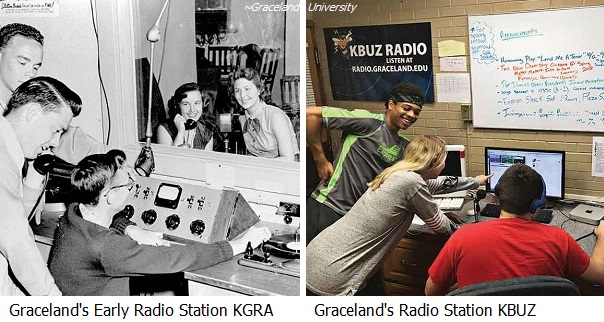 |
|
 Graceland's publications, past and present, are under the supervision of sponsors: The Vespiary is a student-run literary magazine produced annually. This publication began as Brandon Gates' English graduation requirement. Gates, editor of The Tower, attempted to restart Graceland's literary magazine. Graceland's previous literary magazine, Expressions, did not last very long. The Vespiary debuted as a sophisticated and aesthetically appealing publication and subsequent annual publications were handed down to upcoming Tower staff members. The Acacia is the university yearbook, which is also published by students. |
|
|
Graceland's Journalistic Publications Athenian Arena was the first publication issued by Graceland's students as a separate work of journalism. The first monthly issue made its debut in March of 1903 and was discontinued in 1904. Graceland Messenger was published monthly by Graceland's student body under the direction of the Booster Club from December 4, 1912 through the spring of 1914. It was considered to be the first newspaper of the college. The Messenger was supported entirely through subscriptions and advertisements. Original staff members were: manager Ralph W. Johnson, assistant manager Arthur E. Benc, editor-in-chief Irene E. Hoffman, stenographer John W. Roth, collegiate department Grace Thompson, normal department Vada Kennicutt, preparatory department Lonzo Jones, commercial department Ward Hougas, stenography James Wate, oratory Mary Warnock, religious affairs Anna Worlund, athletics John W. Roth and locals James Curtis. Graceland Record was the college newspaper that debuted with an October 8, 1920 issue. Originally a weekly, the Record became a biweekly during its second year. The last issue was published on October 28, 1930. In November of 1930, the student body voted to change the name of the publication to Graceland Tower. Officers for the first issue of the Graceland Record were: editor S. G. Russell, associate editor Leonard Lea, business manager Richard Hartnell, assistant business manager Charles Sandage, advertising manager Alvin Stephenson, athletic editor Daniel B. Sorden, social editor Pat Callahan, studio editor Ruth Juergens, joke editor Roy Cheville, religious education editor Arthur Koehler, Niketes editor Valour Briggs, Victorian editor Orley Reneau, and Alpha Pi Sigma editor David Lewis. Graceland Tower, a name selected by the student body in November of 1930, debuted with the November 7, 1930 issue which was dedicated to the 1930 homecoming. Officers for The Tower were: editor Paul Untnehmer, assistant editor James Moses, features Eva Wallace, athletics Russell Rockwell, alumni Aleta Jensen, social Dorothy Mesle, music Vivian Castings, business manager Dorothy Elliott, assistant business manager Loren McDole, circulation manager Walter Sinclair, and typists Margaret Massie and Margaret Christensen. The Tower began a biweekly publication in February of 1932, then in the fall of 1946 resumed a weekly publication status. The Tower began its distribution through student mailboxes in October of 1946. [Transcriber's Note: H. Alan Smith was editor of the Tower and Sharon Becker was the publication's graphic artist, 1970 - 1973. H. Alan Smith went on to become the publisher and editor of Mount Ayr Record-News.] During the spring of 1976, The Publications Board put The Tower on a biweekly status, but the newspaper returned to a weekly publication schedule at the beginning of the 1978 spring semester. The Tower is presently an online newspaper published by Graceland students that covers the happenings of the campus community in addition to voicing student and faculty opinion. You may find The Tower on Facebook. |
|
 Graceland's Alumni Publications |
|
Following is a list of Graceland's Alumni magazines over the
years: Graceland
College Bulletin Quarterly publication first published in
1906. During 1916-17, The Greater Graceland Association began editing
the publication as a quarterly news bulletin. Graceland
College Bulletin Quarterly publication first published in
1906. During 1916-17, The Greater Graceland Association began editing
the publication as a quarterly news bulletin.The Alumni Tower - Officially known as the Graceland Tower, informally known as the Alumni Tower, this publication made its debut around the year 1941. Frontiers - This alumni magazine debuted in June of 1947. It was edited by R. E. Browne. The Graceland Bulletin - A four-page publication, named The Graceland Bulletin, was printed during the run of the Alumni Tower in May of 1948. It promoted the construction of the Memorial Student Center. Graceland College Bulletin Volume 1, number 1, R. E. Browne, was issued in September of 1948. This appeared in a 6” x 9” format. The Graceland Alumni Magazine - This magazine, under the publication of Barney Parker, appeared with the November/December 1961 issue. The Graceland Alumni Newsletter - The Graceland Alumni Newsletter was published one time with a January/February 1964 issue. The Gracelander - Under editor John A. Barr, the alumni publication was renamed The Gracelander. The Graceland Bulletin - Under editor Richard A. Edwards, Graceland's alumni publication returned to the name The Graceland Bulletin in September of 1971. This issue had a new look, an 11” x 14” “magpaper” format. The September 1972 issue featured lighter paper stock and contained 8 pages. After this issue, the “magpaper” format was dropped. Horizons - Graceland's alumni publication was changed to a magazine format between covers printed on slick paper. It debuted under editor David Perkins in August of 1985. Graceland Horizons - The publication Horizons was changed with the Fall of 1995 issue and resumed under David Goehner. The publication features full-colored cover pages and presently is printed in full-color throughout each issue. Horizons is published three times a year. |
|
 |
|
| Graceland's fight song, Graceland Forever, was written in 1925 by Warren McElwain: | |
|
Graceland Forever, dear Alma Mater |
|
| Graceland's alma mater was written in 1926 by Roy A. Cheville: | |
|
|
|
 |
|
|
SOURCE: Edwards, Paul M. "The Hilltop Where. . . An Informal History
of Graceland College." Venture Foundation. Lamoni IA. 1972. Goehner, David. “The Graceland College Book of Knowledge: From A To Z.” Herald House. Independence MO. 1997. |
|
|
NOTE: Graceland University expressly granted
permission to Decatur County IAGenWeb to use photographs and materials
for the sole purpose of this website. Please, extend courtesy toward Graceland University and Decatur County IAGenWeb ~ ask before you "borrow" photos from this site. Thank you. These pages have been updated and reformatted by Conni McDaniel Hall, October 2019 |
|
| Schools Directory *** Decatur County IAGenWeb | |